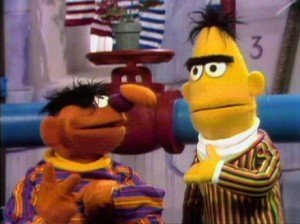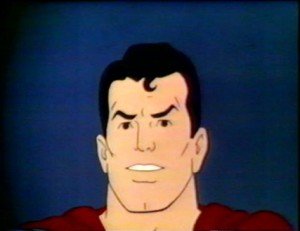Sesame Street Test Pilot
But, returning to the whole some-things-are-very-different-but-some-things-are-shockingly-the-same concept, in one of Bert and Ernie’s later scenes, Ernie pulls a prank that would come to practically define the character in later years. He’s counting various body parts of his, pointing out that he has 2 eyes, 2 ears, and 2 noses. “Hey, you dingaling!” Bert interrupts. “You’ve only got one nose.” Ernie responds by pulling Bert’s nose of his face and attaching it to his own so that he does, indeed, have two noses. The action, of course, becomes a classic recurring gag on Sesame Street, and everything else here, too, from Ernie’s “k-k-k-k” laugh to Bert’s noseless voice are exactly what they’d later be on the show, as if, of course, Bert’s stick-in-the-mud-ness vs. Ernie’s happy-go-lucky mischievous streak.
Another marked difference from how the show would later be is how its cartoon, puppet, and short film segments are presented. In later seasons, scenes on the street would come to have fully developed plots, even story arcs spanning multiple episodes and, in some cases, years, such as Maria and Luis’ romance, marriage, pregnancy, etc. Here, however, the street scenes effectively just act as brief introductions in order to cut away to the various other segments.
And most times, the characters actually introduce them as such. It seems that Joan Ganz Cooney and Co. were so enamored of their “number/letter/etc. ads for kids” concept that they expected them to be the main draw. This is less a coherent show than a series of videos being introduced in various ways. At one point, Susan even directly references the commercial concept by saying to the camera, “We’ll be right back after this important message!” Later on, these cutaways would tend to be worked in much more subtly, making it all flow much more naturally. A smart kid could pick up on the thematic links between the street scene and the accompanying “lesson” segment but that wasn’t necessary to enjoying it. At this point, the show feels less like entertainment and more like just a vehicle for education.
You might also recall how Cooney discussed how the “commercials” would be repeated numerous times per episode, because children both love and learn from repetition. Well, that idea is given the slightest bit of overkill here, when after watching and loving a cartoon about the letter “D”–which is from the same series as the “J” cartoon in the pitch reel, with two little boys being told a funny alliterative story by an adult, this time about a dog playing dice–Ernie appears, and asks if he could see it again. And the cartoon immediately plays again. And when it’s done, Ernie begs again. And once more, it plays! Thankfully, Bert covers Ernie’s mouth when he tries to ask for it a fourth!
Which brings me to another point. Sesame Street was always very good about not being overly didactic in its lessons. In fact, many of the short films were extremely subtle, trusting the kids to subconsciously pick up on various clues without having it condescendingly explained to them step by step. But when they were about a certain letter or number, the segment would at least be about that letter or number in some way.
By contrast, there are a few odd bits in this pilot that are ostensibly meant to present a certain letter but without much rhyme or reason to it. For example, a magician appears twice to perform magic tricks. In the first one, he makes a few cards with various “D”s on them appear, and in the second, he tears up a newspaper, then magically reassembles it, to reveal that the letter “D” is written within it. Later on, such a segment would have drawn some connection between the action and the letter but neither “magician,” “newspaper,” or anything he does links to “D”. It’s entirely arbitrary. Any letter could have been written on there. Now, perhaps if he had made some things disappear, it would be another story.
And then there is the surprising Superman cartoon segment–apparently Batman and Superman would appear in segments in Sesame Street‘s early days–in which he subdues a giant gorilla and saves Lois Lane, ending on the letter “D” again. I watched this bit twice through to try to figure out where the “D” came in. Apparently, it comes from Superman having beaten him back with a door. However, the word is never underlined, and so it completely went over both my and my fiance’s heads, and we’re both in our early 30s and well-educated. Methinks this one was a little too subtle.
Another difference from the Sesame Street I’m used to is Mr. Hooper, who is the same actor I knew as a kid, Will Lee, but infinitely grumpier here than I remember him. From what Muppet Wiki tells me, he was originally more abrasive and mean, with a nice streak hiding underneath, and that his mellowing-out was a gradual process, helped largely by Big Bird’s friendship. But I wonder if he was ever quite as awful to the others in any aired episodes as he is here.



